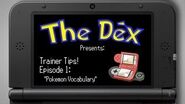The Dex! Trainer Tips Episode 1: Pokemon Vocabulary is the first episode of The Trainer Tips! series. It's hosted by Cueball Alex and Pokekellz and it covers Pokémon Vocabulary! It aired on January 28th, 2013 and can be viewed here.
"Alex and Kellz take a break from their weekly Pokemon Trivia and Battle-Strategy format to bring you a special episode about lingo and terminology." - YouTube Description
Evolution[]
- While evolution is very well known, there are various ways to classify evolution
- Pokémon that haven't evolved, or never will evolve are known as Basic Pokémon
- Examples: Bulbasaur, Tauros, Mewtwo
- Pokémon that have evolved once are known as Stage 1 Pokémon, regardless of if they can evolve again or not
- Examples: Charmeleon, Electivire, Noctowl
- Pokémon that have evolved twice are known as Stage 2 Pokémon. These Pokémon are often regarded as some of the most powerful ones.
- Examples: Blastoise, Poliwrath, Politoed
- Pokémon that have yet to reach their final evolution are known as NFE or Not Fully Evolved.
- Pokémon that can evolve into a Basic Pokémon are known as Baby Pokemon. These are often introduced after the parent evolution
Breeding[]
- Every Pokémon has one or two Egg Groups. These determine which Pokémon can breed together. Two Pokémon must share at least one Egg Group in order to be compatible.
- Egg Groups are usually determined by the Pokémon's appearance or habitat
- Example: The "Fairy Egg Group" contains Jigglypuff, Clefairy, and Chansey
- When breeding, it's important to look at the Nature and Characteristic of the newly hatched Pokémon.
- Natures can either raise one stat but decrease another, or do absolutely nothing
- Example: Timid Nature boosts Speed, but lowers Attack
- Characteristics indicate which Individual Value or IV is the highest. IVs add diversity within a Pokémon species.
- Example: The "Highly Persistent" characteristic indicates that it's Defense IV is the highest.
- Natures can either raise one stat but decrease another, or do absolutely nothing
Training[]
- Often times, Pokémon are picked for battle because of their Base Stats.
- Every species has a value between 0 and 255 for each of its 6 stats. These numbers indicate how much room for growth the Pokémon has in those stats
- Many trainers like to add up all six values to get a Base Stat Total, to gauge the Pokémon's strength
- Example: Magikarp has a Base Stat Total of 200, Arceus has a BST of 720.
- Every Pokémon of the same species has the same Base Stats, and Base Stat Total
- Training a Pokémon is made much easier through Pokérus, a rare disease that makes the infected Pokémon's stats grow faster
- Pokérus doubles the number of Effort Values or EVs a Pokémon receives.
- It is advised that you trade for it, to help spread it to your Pokémon, due to its extreme rarity.
- Every Pokémon species has a Move Pool, which is the list of all moves that a Pokémon has the ability to learn
- The four moves that a Trainer picks to put on a Pokémon is known as the Move Set.
- Moves that do no damage are known as Support Moves, while moves that deal damage are known as Attacks.
Battling[]
- While the act of Battling is very well known, Competitive Battling, is very different.
- Tiers are used to divide up the Pokémon metagame, to make it so that anyone can use their favorite Pokémon, regardless of how good or bad it is.
- This system was put into place by Smogon. There is no official tier system, so it is entirely fan run. They keep track of how people use Pokémon, and place each one into a tier to keep things relatively balanced.
- The Uber Tier is the highest tier, filled with the strongest legendaries, and other incredibly strong Pokémon
- Examples: Arceus, Mewtwo, Giratina, Blaziken
- The OverUsed Tier or OU is next. It is filled with the most used Pokémon and is the most popular format.
- Examples: Gengar, Scizor
- The tiers under OU are all based on how frequently the Pokémon is used. The more they are used, they higher they are placed. These tiers are UnderUsed (UU), Rarely Used (RU), and Never Used (NU)
- There are also Borderline tiers in-between each tier, for Pokémon that are too good for one tier, but don't quiet get enough usage in the other.
- The Little Cup is a tier for Pokémon that are Level 5. Only Pokémon with the ability to evolve are allowed in.
- When battling there are various roles that each Pokémon should fulfill.
- Leads are what you typically throw out first. They are often very fast, and have the ability to set up Entry Hazards
- Examples: Azelf, Aerodactyl
- Sweepers are designed to hit very hard, very quickly. They can be either Physical or Special
- Examples: Garchomp, Chandelure
- Tanks are defense minded Pokémon that can take a hit from a sweeper. They often times inflict status conditions, and can heal themselves
- Examples: Hippowdon, Blissey
- Leads are what you typically throw out first. They are often very fast, and have the ability to set up Entry Hazards
- When a Pokémon uses a move of their type, they gain STAB or Same Type Attack Bonus.
- This Bonus will increase your damage output by 50%
- Example: Pikachu using Thunderbolt.



